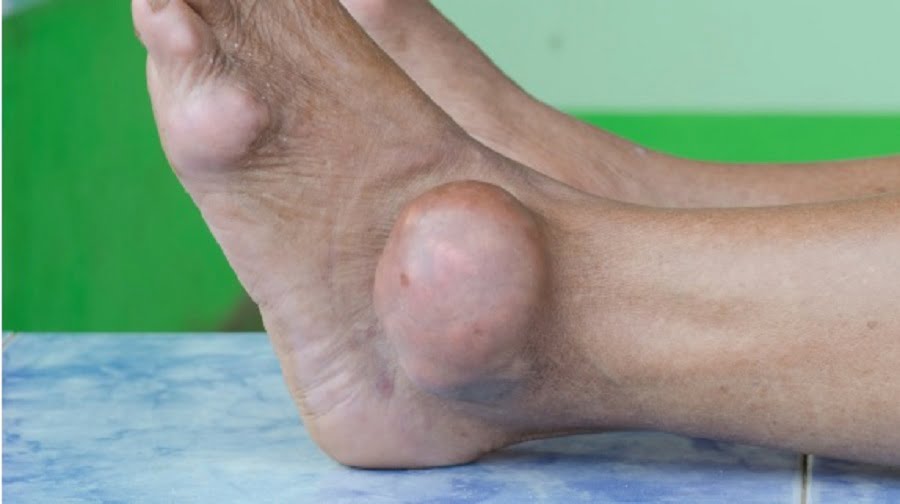Introduction to Gout
What is Gout?
Gout is a type of inflammatory arthritis that is characterized by sudden and severe attacks of pain, swelling, redness, and stiffness in the joints. The joints most commonly affected are the ones in the big toe, but gout can also affect other joints in the body. The pain caused by gout can be excruciating and can make it difficult for people to move around or perform everyday tasks.

Gout is caused by the buildup of uric acid crystals in the joints. Uric acid is a waste product that is produced when the body breaks down purines, which are found in many foods and beverages, including red meat, shellfish, and alcohol. Normally, uric acid is dissolved in the blood and is excreted from the body through the kidneys. However, when there is too much uric acid in the blood, it can crystallize and form deposits in the joints, leading to inflammation, swelling, and pain.
There are also certain risk factors that can increase a person's chances of developing gout. These include:
- Age: Gout is more common in older adults, particularly men over the age of 40.
- Gender: Men are more likely to develop gout than women, although women can still develop it, particularly after menopause.
- Genetics: Some people have a genetic predisposition to developing gout.
- Obesity: Being overweight or obese can increase the risk of gout, as well as other health problems.
- Certain medical conditions: People with certain medical conditions, such as diabetes, high blood pressure, and kidney disease, are more at risk of developing gout.
- Medications: Certain medications, such as diuretics and aspirin, can increase the risk of gout.
In conclusion, gout is a type of arthritis that is caused by the buildup of uric acid crystals in the joints. It can be extremely painful and can make it difficult for people to perform daily activities. Although it is more common in older adults and men, anyone can develop gout if they have certain risk factors. In the next sections of this blog, we will discuss the symptoms, diagnosis, and treatment of gout in more detail.
:max_bytes(150000):strip_icc()/VWH-GettyImages-1257061059-8d040ae936694cf2ba54599d43a68992.jpg)
Symptoms and Diagnosis of Gout
Typical signs and symptoms of Gout
Gout is a type of inflammatory arthritis that causes sudden and severe pain, swelling, redness, and stiffness in the joints. The joint most commonly affected is the big toe, but gout can also affect other joints, such as the ankle, knee, wrist, and fingers. The pain caused by gout is usually intense and can be described as stabbing or throbbing, making it challenging for individuals to move the affected joint. Gout attacks often occur at night and can last for a few days or up to several weeks. Some typical signs and symptoms of gout include:
- Warmth, swelling, and tenderness in the affected joint
- Appearance of red or purple discoloration on the skin around the joint
- Stiffness and limited range of motion in the affected joint
- Fever and chills
- Fatigue and weakness
It is essential to seek medical attention if you experience any of the above symptoms, which may require prompt treatment.
How is Gout diagnosed?
To diagnose gout, doctors usually take into consideration a patient's medical history, physical examination, and laboratory tests. During the physical examination, the doctor may look for signs of inflammation, such as swelling, redness, warmth, and pain in the joints. They may also check for the presence of uric acid crystals in the joint fluid using a needle to extract a small sample of fluid from the affected joint. This test can help confirm the diagnosis of gout.
Several laboratory tests may also be done to help diagnose gout, including blood tests to measure uric acid levels in the blood. However, elevated uric acid levels do not always mean a person has gout, and some people with high uric acid levels may never experience gout symptoms. Imaging tests such as X-rays, CT scans, and MRI may be done to evaluate joint damage caused by gout.
In summary, gout is diagnosed based on a combination of a patient's history, physical examination, and laboratory tests. If left untreated, gout can cause permanent joint damage, so it is essential to seek medical attention if you experience any gout symptoms. In the next section of this blog, we will discuss the various treatment options available for managing gout.

Gout Triggers
What triggers a Gout flare-up?
Gout is a type of inflammatory arthritis caused by an accumulation of uric acid crystals in the joints. Gout flare-ups can be triggered by several factors, such as:- Diet: Eating foods high in purines, such as red meat, organ meats, and seafood, can increase uric acid levels and trigger a gout flare-up.
- Dehydration: When the body is dehydrated, the uric acid concentration in the blood increases, leading to gout attacks.
- Alcohol consumption: Alcohol, especially beer, can increase uric acid levels and trigger gout attacks.
- Stress: Stress and anxiety can cause a gout flare-up by increasing inflammatory responses in the body.
- Medications: Certain medications, such as diuretics and aspirin, can interfere with uric acid excretion and increase the risk of gout attacks.
How to avoid Gout triggers
Preventing gout attacks involves avoiding triggers that increase uric acid levels in the blood. Some ways to avoid gout triggers include:- Diet: Consuming a low-purine diet can reduce the risk of gout attacks. A low-purine diet includes fruits, vegetables, whole grains, low-fat dairy products, and lean protein sources like chicken, turkey, and beans.
- Drinking lots of water: Staying hydrated helps to flush uric acid from the body, reducing the likelihood of gout flare-ups.
- Limiting alcohol consumption: Reducing alcohol intake or avoiding it altogether can reduce the risk of gout attacks.
- Managing stress: Avoiding stress or using stress-management techniques, such as meditation or yoga, can reduce inflammatory responses and lower the risk of gout attacks.
- Talking to a doctor: If you are taking medications that could be triggering gout attacks, talk to your doctor about alternative medications or ways to manage the risk of gout attacks.
In conclusion, managing gout involves avoiding triggers that increase uric acid levels and following a healthy lifestyle. By understanding what triggers gout attacks and taking steps to reduce the risk of these triggers, individuals with gout can manage their condition effectively. If you experience persistent gout symptoms, seek medical attention to prevent permanent joint damage.
:max_bytes(150000):strip_icc()/VWH_Illustration_What-to-Know-About-PsA-and-Gout_Illustrator_Jessica-Olah_Final-c25629edf0cf4f8baef3651f86f82df3.jpg)
Understanding Bone and Joint Inflammation: Causes, Symptoms, and Treatments
Hip replacement: A surgical procedure that involves replacing a damaged hip joint with an artificial one
Promising Research and Developments for Rheumatoid Arthritis Treatments
Rheumatoid Arthritis in Children: Signs, Symptoms, and Treatment
Overcoming Fatigue and Depression Associated with Rheumatoid Arthritis
The Relationship Between Diet and Rheumatoid Arthritis Management
When to Seek Medical Help for Rheumatoid Arthritis
Key Differences Between Rheumatoid Arthritis and Osteoarthritis
Living with Rheumatoid Arthritis: Coping Strategies and Treatment Options
Understanding the Symptoms and Causes of Rheumatoid Arthritis
Gout Treatment Options
While there is no cure for gout, there are several treatment options available that can help manage the symptoms and prevent flares. These treatment options include medications and lifestyle modifications.
Medications used to treat Gout
There are several medications that can be used to manage gout, including:
- Nonsteroidal anti-inflammatory drugs (NSAIDs): These medications can relieve pain and reduce inflammation during a gout flare-up.
- Corticosteroids: Corticosteroids can be taken orally or injected directly into the joint to reduce inflammation and pain.
- Xanthine oxidase inhibitors: These medications can reduce uric acid production to prevent gout attacks. Examples include allopurinol and febuxostat.
- Uricosurics: These medications help the body excrete uric acid. Examples include probenecid and lesinurad.
It's important to talk to a doctor before starting any medication for gout, as some medications can interact with other medications or have side effects.
Lifestyle modifications for managing Gout
In addition to medications, lifestyle modifications can also help manage gout. These modifications include:
- Diet: Consuming a low-purine diet can reduce the risk of gout attacks. A low-purine diet includes limiting or avoiding high-purine foods such as red meat, organ meats, seafood, and alcohol.
- Weight loss: Losing weight can help reduce the risk of gout attacks, as excess weight can contribute to high uric acid levels in the body.
- Exercise: Regular exercise can help regulate weight and improve overall joint health, reducing the risk of gout attacks.
- Hydration: Staying hydrated can help flush uric acid from the body, reducing the likelihood of gout flare-ups.
- Avoiding triggers: As mentioned previously, avoiding triggers such as high-purine foods, alcohol, and stress can help prevent gout flares.
In conclusion, managing gout involves a combination of medications and lifestyle modifications. By working with a healthcare professional, individuals with gout can develop a personalized treatment plan to manage their condition effectively.

